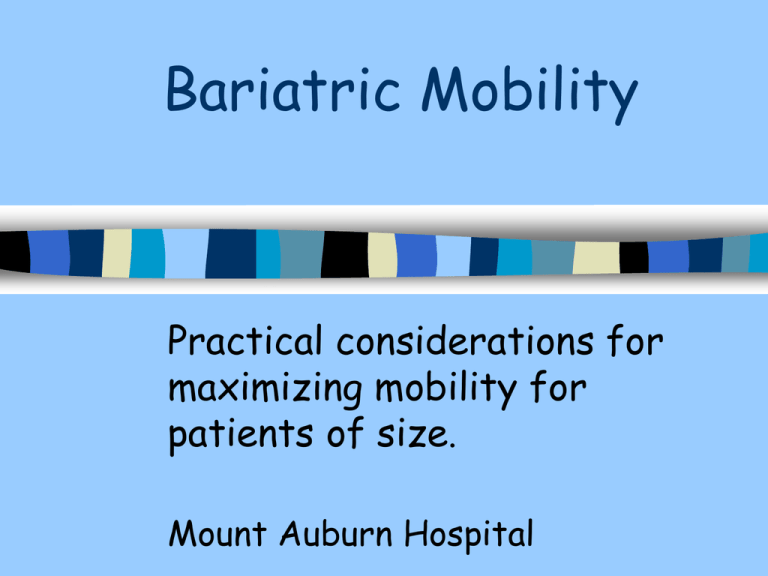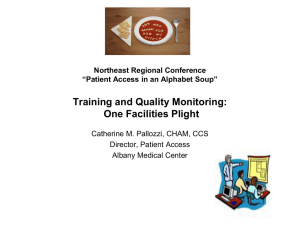Bariatric Mobility
advertisement

Bariatric Mobility Practical considerations for maximizing mobility for patients of size. Mount Auburn Hospital Bed mobility considerations Use appropriately sized beds. Patients likely have preferred bed mobility techniques based on body size and shape. Elevated risk of friction injuries. Use of friction reducing sheets, Trendelenburg position, airflow mattress, bed rails, additional assistants. Body shape and bed mobility “Apple” shape body type Dominate abdominal girth. Abdominal wall may be rigid and non moving, or may have low, mobile pannus. Usually cannot tolerate supine or prone positions. Respiratory function may be compromised by size. Difficulty rolling. Typically don’t roll to sit up. Will spin to bring legs over edge and then sit up. May require wider bed. Body Shape and Bed Mobility “Pear” Shape Body Type May have excessive posterior tissue bulk. May have excessive tissue on outer aspects of thighs and hips. May have increased low back pain due to excessive posterior tissue. Patients with tissue bulk on outside of thighs can usually roll more easily. Supine to long sit or side lying to sitting with rail. Tips for safe mobility It is very difficult to prevent or stop a slide from edge of bed if patient is dependent. Be careful while helping someone move from sidelying to sitting at edge of bed. Tips for safe mobility Have bed as low as possible so when sitting up the patient’s knees don’t drop below the height of their hips. While moving to edge of bed, prepare surfaces to allow patient’s knees to align with hip joint. Tips for safe mobility Use foot stool to pre-position patients thigh before trunk elevation. ALWAYS avoid a down slopping thigh while at edge of bed. First attempt: Debut Transfer Safety The Egress Test should be used if mobility status is unclear and it is the first time the person is getting up out of bed. The Egress Test is a simple and practical way to assess patient’s ability to complete bed to chair transfer before leaving safe zone at edge of bed. Egress Test: 3 Phase Progression 1. Three repetitions of sit to stand, the 1st attempt the patient lifts buttocks off surface. The 2nd and 3rd attempts are full sit to stand. 2. Three steps of marching in place (with baseline assistive device) 3. Advance step and return to each foot. Egress Test: Phase 1 Three Reps of Sit to Stand..\image004[2].jpg Rep 1- Can patient elevate from and clear support surface by only 1-2 inches? This clearing rep verifies the patient’s weight-bearing ability to perform the task without physical assistance. The clearing test also allows the care provider to assess that the set up is safe. The patient then completes 2 full sit to stand reps. A mechanical transfer assist should be used if the patient requires assistance beyond cues and guarding to complete any part of this phase. Egress Test: Phase 2 Three Steps of Marching in Place This assesses patients’ ability to lift and weight bear on each leg for 3 steps in place. This is a strength and endurance test. Be prepared to redirect patient back and down to starting surface. Maintain close contact with patient throughout and use appropriate body mechanics. If the patient requires any assistance beyond cues and guarding techniques then a mechanical transfer assist should be used. Egress Test Phase 3 Advance Step and Return Each Foot This test assesses patient’s ability to step forward and backward before stepping fully away from beside surface. While you are in a guarding position ask the patient to advance one leg forward and then return it back to the starting position. The task is repeated for the other leg. If the patient can’t bring a leg back to the starting position, cue the patient to shift weight back onto trailing leg and sit on the support surface. Back of the trailing leg should always be touching the starting surface for possible retreat during this test. Use a mechanical transfer assist if patient needs any assistance beyond guarding and cues. Equipment Considerations Most of the rolling walkers on the floors support up to 300 pounds. You can confirm weight capacity by looking for sticker on walker. Confirm that the width is adequate. We have wider bariatric rolling walkers that can support up to 500 pounds as needed. Call PT if you need to find one. Most of the standard recliners and tall back chairs support up to 300 pounds. Consider chair width before using. Support patient’s feet with step stools while sitting at edge of bed. Bariatric recliners on N3 support up to 580 pounds. Transport can help you find a wheelchair to accommodate your patient if over 250 pounds. Transfer Assist Devices: Sara 3000 standing and raising aid Supports up to 440 pounds Used with patients who can weight bear on legs. Need adequate trunk support. Use with patients who need more than just guarding to safely perform any part of Egress Test. Transfer assist devices Maxi Move Dependent Transfer Total passive lift for patient who cannot weight bear minimally on legs. Used for patients who cannot sit at edge of bed without significant physical assistance. Supports up to 500 pounds and can lift someone from the floor. Transfer assist devices Do not attempt to use either the Sara 3000 or the Maxi Move until you have completed training and the competency. If you need further training on either device, let your nurse manager know. Bariatric Mobility Test 1. Which Body Shape can roll easier? A. Apple shaped B. Pear shaped C. Squash shaped D. All can roll equally as easy 2. The Egress test has A. 1 Phase: Get up and go B. 2 Phases: Sit to stand, and advanced step C. 3 Phases: Sit to stand, marching in place and step forward/back with single leg D. 4 Phases: Sit to stand, marching in place, step forward/back with single leg , and take a stroll 3. Your 450lb bariatric patient has fallen to the floor and cannot get up. Which device will be needed to lift him? A. Stedy B. Sara 200 C. Sara 3000 D. Maxi Move 4. When assisting a patient to a sitting position on the edge of the bed it is important to: A. Have the bed as low as possible B. Avoid positioning in the knees below the hips C. Use a foot stool to position thighs before elevating patient trunk D. All of the above 5. You have a 400lb patient who has good trunk control up in the chair. He can usually bear weight fine but is too tired to get up on his own. Which device should be used to assist getting him back to bed A. B. C. D. Stedy Sara 200 Sara 3000 Maxi Move








